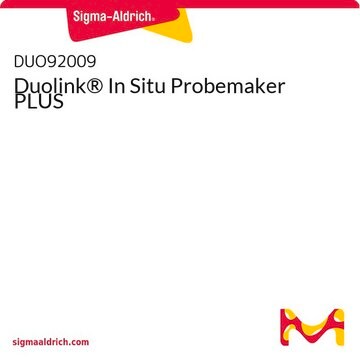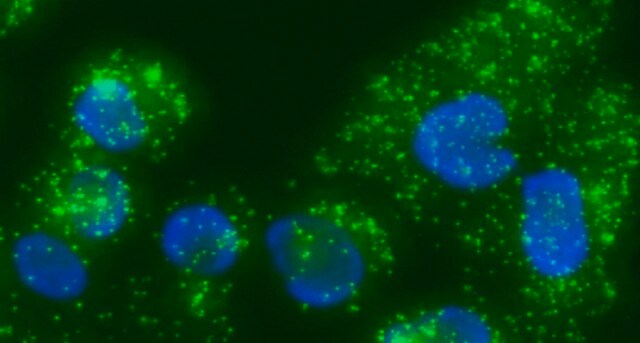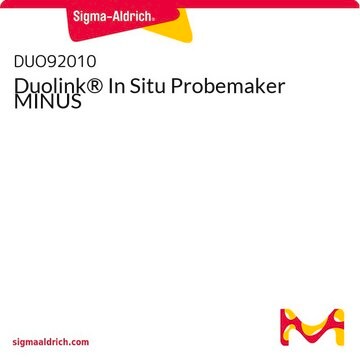Transportation information can be found in Section 14 of the product's (M)SDS.To access the shipping information for this material, use the link on the product detail page for the product.
추천 제품
생물학적 소스
donkey (polyclonal)
Quality Level
항체 형태
affinity purified immunoglobulin (secondary antibody)
항체 생산 유형
primary antibodies
제품 라인
Duolink®
종 반응성
goat
기술
immunofluorescence: suitable
proximity ligation assay: suitable
적합성
suitable for brightfield
suitable for fluorescence
배송 상태
wet ice
저장 온도
2-8°C
애플리케이션
This product can be applied to both the Duolink® In Situ Fluorescence Protocol and the Duolink® In Situ Brightfield Protocol depending on the detection reagents used.
Visit our Duolink® PLA Resource Center for information on how to run a Duolink® experiment, applications, troubleshooting, and more.
To perform a complete Duolink® PLA in situ experiment you will need two primary antibodies (PLA, IHC, ICC or IF validated) that recognize two target epitopes. Other necessary reagents include a pair of PLA probes from different species (one PLUS and one MINUS), detection reagents, wash buffers, and mounting medium. Note that the primary antibodies must come from the same species as the Duolink® PLA probes. Analysis is carried out using standard immunofluorescence assay equipment.HRP is also available for brightfield detection.
PLA probe anti-Goat reacts with whole molecule goat IgG and the light chains of other goat immunoglobulin?s. The PLA probe anti-Goat may cross-react with sheep antibodies, but has minimal cross reactivity with chicken, guinea pig, Syrian hamster, horse, human, mouse,rabbit, and rat serum proteins. A PLUS probe of a different species must be used simultaneously with this product. See our Product Selection Guide for more information.
Application Note
Two primary antibodies raised in different species are needed. Test your primary antibodies (IgG-class, mono- or polyclonal) in a standard immunofluorescence (IF), immunohistochemistry (IHC) or immunocytochemistry (ICC) assay to determine the optimal fixation, blocking, and titer conditions. Duolink®PLA in situ reagents are suitable for use on fixed cells, cytospin cells, cells grown on slide, formalin-fixed, paraffin embedded (FFPE), or tissue (fresh or frozen). No minimum number of cells is required.
Let us do the work for you, learn more about our Custom Service Program to accelerate your Duolink® projects
View full Duolink® product list
특징 및 장점
- No overexpression or genetic manipulation required
- High specificity (fewer false positives)
- Single molecule sensitivity due to rolling circle amplification
- Relative quantification possible
- No special equipment needed
- Quicker and simpler than FRET
- Increased accuracy compared to co-IP
- Publication-ready results
성분
- 5x PLA Probe Anti-Goat MINUS - Donkey anti-goat secondary antibody conjugated to oligonucleotide MINUS
- 1x Blocking Solution - Reagent for blocking of the sample
- 1x Antibody Diluent - For dilution of PLA probes and primary antibodies
법적 정보
적합한 제품을 찾을 수 없으신가요?
당사의 제품 선택기 도구.을(를) 시도해 보세요.
Storage Class Code
10 - Combustible liquids
가장 최신 버전 중 하나를 선택하세요:
시험 성적서(COA)
이미 열람한 고객
문서
Support information including tips and tricks, frequently asked questions, and basic troubleshooting.
Things to consider for preparation, setup and execution of the Duolink® assay protocol
프로토콜
Duolink® PLA reagents enable brightfield detection and quantification of proteins and interactions in tissue samples.
관련 콘텐츠
Applications to detect, quantify and visualize protein-protein interactions, post-translational modifications and low expression protein detection using proximity ligation assay
-
What is the Department of Transportation shipping information for this product?
1 답변-
도움이 되었습니까?
-
-
What epitope on the antibody is recognized by the Duolink PLA Probes?
1 답변-
The Duolink PLA Probes offered are donkey polyclonal antibodies directed to the whole molecule (heavy and light chains). They are affinity purified. The same polyclonal antibody is conjugated to the Plus and Minus Oligos. The Plus and Minus probes can be used together (to detect a single antibody) since they can recognize multiple sites. The anti-mouse IgG PLA labeled antibodies may cross-react with rat but this is not consistent. Do not use this product with rat antibodies. It is best to label anti-rat secondary antibodies with the Duolink Probemaker kit.The anti-goat IgG PLA labeled antibodies have cross-reactivity with sheep IgG and can be recommended for this application.
도움이 되었습니까?
-
-
How many reactions can be performed with the Duolink® In Situ Starter Kit?
1 답변-
All of the starter kits for the Duolink product line will perform 30 reactions using 40 ul per reaction. DUO92101 - Duolink® In Situ Red Starter Kit Mouse/Rabbit DUO92102 - Duolink® In Situ Orange Starter Kit Mouse/Rabbit DUO92103 - Duolink® In Situ Red Starter Kit Mouse/Goat DUO92104 - Duolink® In Situ Orange Starter Kit Mouse/Goat DUO92105 - Duolink® In Situ Red Starter Kit Goat/Rabbit DUO92106 - Duolink® In Situ Orange Starter Kit Goat/Rabbit
도움이 되었습니까?
-
-
Has Duolink been used for detection of changes in protein expression?
1 답변-
The following reference cites the use of Duolink to detect changes in protein expression in Human. Raizer et al., Cancer 2010;116:5297-305
도움이 되었습니까?
-
활성 필터
자사의 과학자팀은 생명 과학, 재료 과학, 화학 합성, 크로마토그래피, 분석 및 기타 많은 영역을 포함한 모든 과학 분야에 경험이 있습니다..
고객지원팀으로 연락바랍니다.








